There be dragons!
23 April is not only Shakespeare’s birthday but also St George’s Day. St George is the patron saint of England.
There are several ways for us to mark the occasion but this year I want to talk about the Dragons of London.

London Guided Walks » Episode 5: The Dragons of London
There be dragons!
23 April is not only Shakespeare’s birthday but also St George’s Day. St George is the patron saint of England.
There are several ways for us to mark the occasion but this year I want to talk about the Dragons of London.

Your Host: Hazel Baker
Hazel is an active Londoner, a keen theatre-goer and qualified CIGA London tour guide.
She has won awards for tour guiding and is proud to be involved with some great organisations. She is a freeman of the Worshipful Company of Marketors and am an honorary member of The Leaders Council.
She has been an expert guest on Channel 5’s Walking Wartime Britain (Episode 3) and Yesterday Channel’s The Architecture the Railways Built (Series 3, Episode 7).
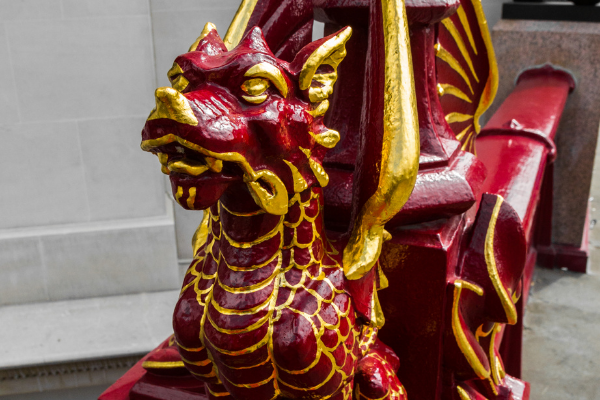
Hazel: Hello and welcome to London Guided Walks London History podcast. In the coming episodes, we will be sharing our love and passion for London, its people, places and history in an espresso shot with a splash of personality. For those of you who don’t know me, I am Hazel Baker, founder of London Guided Walks, providing guided walks and private tours to Londoners and visitors alike.
The 23rd of April is not only Shakespeare’s birthday, it is also St. George’s Day. St. George being the patron saint of England. There are several ways for us to uncover St. George in London. But this year, I want to talk about one of my great loves, and that is the dragons of London. The dragon is a creature which above all others has haunted our imaginations throughout time, the dragon has left its mark in folklore of our ancestors. In the Western world, almost all dragon stories portray the dragon as the villain, from whom the hero must protect the city, or indeed the princess. But some dragons can take on the form of the protector. Although the time that dragons first appeared in myths isn’t known for sure, they can be traced back as far as approximately 4000 BC. Now, dragons is said to have been able to live almost anywhere, depending on the type of dragon mentioned. Their habitats range from the centre of the Earth to the middle of the ocean, they could also be found in caves, fire, or anywhere, dark and damp. And of course, you can find hundreds of them in London.
Now, as I’m sure you’ve heard, from Episode One, London as we know it, would never have existed, were it not for the Romans. Now, the Romans don’t have dragons that are unique to them. Their dragons are based on stories from Greek mythology, and they expanded on those and changed the names to Roman names. And Roman dragons combine the serpentine Greek dragons with the dragons of the near east to give us a dragon that is closer to what we would imagine a European dragon to be, with a long body, full clawed feet and crests upon their heads. The generals of Rome often used dragons as an excuse for not completing their missions, handy there. In the third century BC, General Attilios Regulus was in North Africa, battling Carthage, at backward a river, a dragon attacked his army. According to the report, a dragon crept up and situated itself behind the Romans’ army wall. General Regulus ordered his men to kill it, which they did. But not before it was able to kill a number of their colleagues. Many soldiers were taken by the dragon’s vicious mouth and many were crushed by its tail, its hide was too thick for their weapons to get through. So, they started using siege weapons to crush it with heavy stones. They skinned the creature and sent it way back to Rome to the Senate there. When the Senate measured the skin, it was 120 feet in length. The hide was on display in Rome for 100 years. So, when the Romans came to London, the dragons came too.
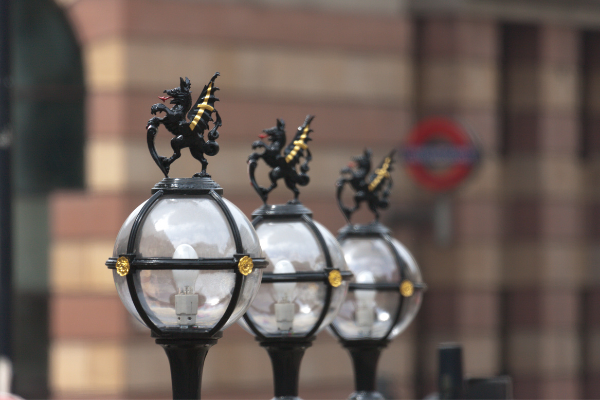
During the second century AD, the Roman cavalry adopted the Draco as their military standard. It took the form of a large dragon on the end of a lance with silvered gaping jaws with the rest of the body made of coloured silk. The jaws faced the wind so the silk body could inflate and ripple in the air. The Romans first usage during the Hippica Gymnasia, their cavalry games. These games were glamorous training exercises that were performed in decorated armour. The Draco was used as a target for the opposing team to hit to score points. From these games, the Draco was adopted as a normal military standard, and was used as a standard until the fall of the empire in 476 A D.
In England, we associate St. George with slaying the dragon, and indeed dragons guard to the City of London too, and they mark out the different gates of the city, i.e. Aldgate, Bishopsgate, Temple Bar and Moorgate. Dragons have been used in stories to protect something as well, think of Smaug in J.R.R Tolkien’s 1937 novel, The Hobbit, who protects Arable, I’ll be it for himself. The City of London boundary dragons are cast iron dragon statues on metal or stone plants. The dragons are painted silver with details of their wings and tongue picked out in red. The dragon stands on its two rare legs, with its right foreleg raised and the left foreleg holding a shield, which bears the city of London’s coat of arms painted in red and white. The design of these dragons are based on two large dragon sculptures, which is seven feet high, mounted on the entrance of the coal exchange on Lower Thames Street and they were designed by city architect JB Bunning, and made by London founder, Dewer in 1849. The dragons were preserved when the coal exchange was demolished in 1962, and the two original statues are were re-erected on six feet high plants of Portland stone at the western boundary of the city, by temple gardens on Victoria embankment.
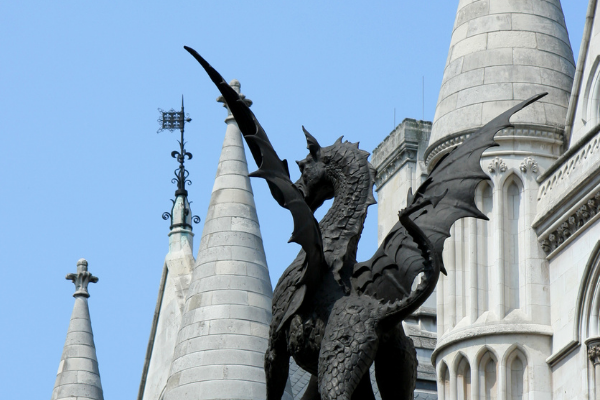
Some of my favourite dragons in the City of London are those on the monument. Maybe because they’ve been there for over 300 years and look a little bit worn. They are the work of Edward Pierce Jr, a sculptor and architect, frequently employed by Sir Christopher Wren, and they costed about 50 pounds, each dragon. But where is the fifth dragon? If you look at the west facing plaque done by Keys Gabriel Cibber, you will notice a dragon underneath the figure of a woman representing the City of London. He is supporting with his pole, the shield of the City of London and with his back, he’s trying to support her. You could argue, however, that this dragon looks much more like a dog.
Joining me today is Hannah Chutspah, Chief Dragon Twitcher from Dragons of London. Hello.
Hannah: Hello.
Hazel: My first question is, what is a Chief Dragon Twitcher?
Hannah: Well, as the founder of Dragons of London, what we do is we are recording the unique biodiversity of London’s dragon population so, much like bird watchers but watching dragons. Whether that’s in dragons which appear to be in architecture or street art, or dragons in public spaces. But despite the rumours, they are real, and not statues and paintings and street signs.

Hazel: And dragons are so much cooler than birds anyway, aren’t they?
Hannah: Yes, I think, personally, I am biased I think dragons are a lot cooler than birds. And there’s just a much wider variety in terms of size, shape, colour. Yes.
Hazel: What was it about Dragons in London that first got you interested?
Hannah: So, I’ve always been someone who sort of spots the interesting bits of architecture, the twiddles, the ornamental elements, and I started to realise that dragons are one of the most common– they’re not the most common motif, but they’re one of the most regular notably cool things that you’ll spot in architecture and design out and about in London.
Hazel: And what has kept you so interested in Dragon twitching?
Hannah: So, there’s a huge variety in dragons, both in sort of what they look like, there’s a lot of species variation, and but there’s also a huge variety of where they appear. So, there’s everything from sort of heraldic type dragons turning up in lots of sort of formal and historical parts of London but you’ve also got say, an absolutely giant dragon taking up multiple floors outside of Camden all you can eat buffet. And they turn up in sort of pubs, restaurants, a lot of Asian restaurants has a huge sort of variety and shapes and styles from sort of very– from sort of palaces and cathedrals right through to your local Buddha or your local restaurant.
Hazel: And what is it about dragons that keeps you interested?
Hannah: So, I really like that they appear across London in a lot of variety of places and styles.
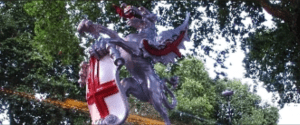
Hazel: And what got you started in all of this?
Hannah: So, the honest answer is I have ADHD and I am wired for novelty. I always notice sort of people’s jewellery or the interesting architectural, decorative elements. I just, I think I’m naturally a bit of a treasure hunter in some ways, I’m also a licensed mudlark, I like looking for cool things. But there were one or two dragons, which I noticed when I was out and about which especially caught my eye, where I just found myself, which suddenly sort of attuned me to looking specifically for dragons. And once I started looking, I didn’t stop.
Hazel: You had no idea how this was going to catch on?
Hannah: I had no idea when I started the Dragons of London that it would become this big a thing or that people would be able to send them in from quite so many places. And that’s something I really enjoy.
Hazel: There’s something extra, isn’t there? About the physical walking around London and enjoying the science and seeing a few things that maybe most people will pass 1000 times and never notice.
Hannah: And it also kind of gamifies walking around town.
Hazel: Yes, absolutely.
Hannah: I sometimes realise that, “Oh, I’m near Coney Hatch Lane, I heard someone say that there was something really cool on a roof around here, I’ll have a little look.”.
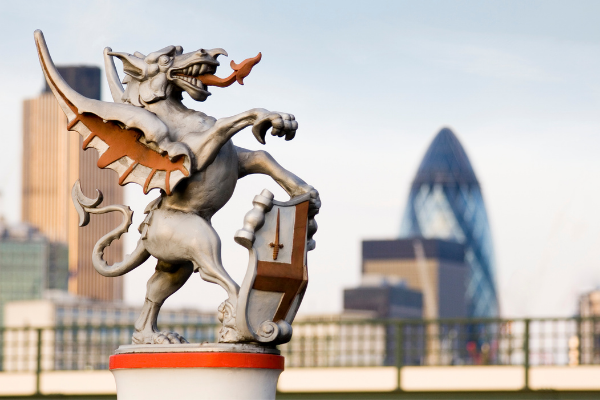
Hazel: So, that means essentially that you’re experiencing London in a way that most people don’t even consider?
Hannah: It both opens up London in a different way, and also, it kind of encourages me to see more of it as well, to wander around more different places, just in case, because you never know what you’ll see.
Hazel: No, yeah, absolutely. I mean, we first connected over Instagram, wasn’t it? About a year ago now, when I was doing my dragon talk for the Mayor of London’s St. George’s celebrations in Trafalgar Square, it was just about the same time as you were actually setting up your Instagram account as well, and you’ve got a really active following, haven’t you? I mean, these are people who are really dedicated of sharing their love and enthusiasm for these exquisite animals.
Hannah: Yes. The first few tip offs were from people I knew who I sort of, who’d spotted me doing this new project on social media. But yeah, I’ve been delighted by how far afield things come in, and there’s one or two people who have become very regular, who are some of our Star Dragon Twitchers who also have started really looking out for it. But, yeah, we get them sent in from everywhere, from street art to these days with the lock down, there’s more much more coming in from sort of suburban locations, often nesting on the very top of roof looking a lot like an architectural finial, but it’s not; it’s a real dragon, I promise.
Hazel: And people are sending them from far and wide, aren’t they? There’s dragons everywhere.
Hannah: Yeah, they’ve been coming in from far and wide at this point. And we’ve also had lots of people sending them in from other parts of the world, which is lovely, but we are, we do have a geographical remit. Mostly just so that you can actually, if you are in London, you should be able to go see all of them, quarantine restrictions notwithstanding, but I like the idea that everything is visible within sort of the range and Oyster card.
Hazel: It is a tremendous amount of fun. I’ve spent many a happier hour, walking around the streets of London, mostly looking up and walking into a few lampposts along the way. Now, if anybody else wants to get involved, how do they do that?
Hannah: So, people can get involved by, if they see, “If you see a dragon, snap a dragon” is our slogan. So, if you see a dragon out in the world, by which I mean not pets, if you have lovely figurines or toys, that’s great, but we’re focused on ones in the public domain. And yeah, if you see a dragon, take a photo and send it in, let us know where you spotted it as well because we really like being able to say, “These are all the green ones.”, or “These are all the ones in Richmond.”, or and so that you can sort of categorise them and have a look on our website. And if people aren’t able to get a good photo, but they do know where dragons are, we are also delighted to get tip offs.
Hazel: And what about this time with lock down, are you able to see enough dragons to feed your habit and is technology your friend?
Hannah: We started using Google street view a bit to sort of patch in where we can’t go visit them ourselves. But I’ve got a camera with a scarily good zoom lens so, even if you can only get a blurry snap on your phone, send it in, and you know when I’m allowed out again, I will see if I can get a high res photo of it. So, if people want to get in touch with us on our social media channels, which is @DragonsofLondon on Instagram and Twitter, and on Facebook, our page is Dragons of London. Also, the email address is Dragontwitchers@gmail.com all one word, and our website is dragonsoflondon.org.
Hazel: And fear not, I’ll add all of these into the show notes, just in case you’re driving somewhere and want to take note of that. So, Hannah, you mentioned there is a wide variety of dragons to be seen, but where can people see dragons in London? Is it really that simple of just opening your eyes and looking around?
Hannah: Almost, good question. There are a lot of dragons about if you start looking for them. If you’re actually in the City of London then there are, usually there’s a lot of grey dragons with the little red flash on their wings, the red-tipped Londiniums, and they are about on almost every, they nest on almost every street sign and bollard but there’s also some of the most famous dragons in London are the boundary dragons. There are dragons, they’re about two-foot-tall or so, marking the boundaries in and out of the city of London, dotted around central London sort of on that perimeter. On the tops of church spires sometimes, but also things like plaster workings of fancy old-fashioned pubs.
Hazel: Now, hopefully most Londoners will be able to point out a boundary dragon if they’d seen one. But, how did it all start, wherever they come from?
Hannah: They descend from an original breeding pair that were on the London coal exchange which is a big ornate Victorian building, and that was demolished I think in the 60’s. It was on, what is now Lower Thames Street. And those– that original pair, they fled the nest and perched on the boundary of Victoria Embankment, but then they have a number of their children are dotted around guarding central London.
Hazel: Yes, and these must be the red tipped Londiniums you were mentioning before. And thanks, Hannah, for sharing your dragon twitching love with us. And for anybody who wants to get started on looking for these magnificent beasts themselves, then get my free top 10 dragons in the City of London guide. And don’t forget to tag Hannah @DragonsofLondon on Twitter, Instagram and Facebook for those that you find. And for those of you who want to look at more detail of the Dragons in London and know their history there, we do provide a private dragon tour and all details are available on our website. That’s all from us for now.